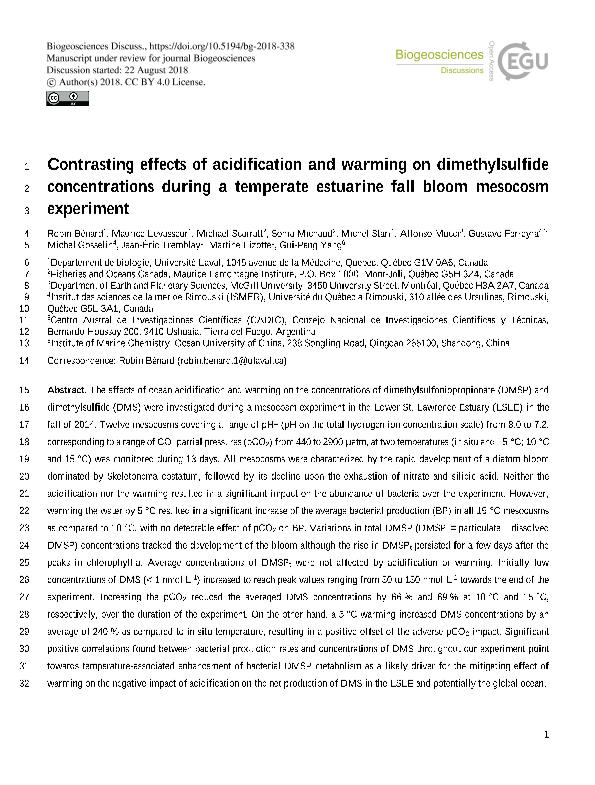Mostrar el registro sencillo del ítem
dc.contributor.author
Benard, Robin
dc.contributor.author
Ferreyra, Gustavo Adolfo

dc.contributor.author
Michael, Scarratt
dc.contributor.author
Sonia, Michaud
dc.contributor.author
Michel, Starr
dc.contributor.author
Alfonso, Mucci
dc.contributor.author
Ferreyra, Gustavo Adolfo

dc.contributor.author
Gosselin, Michel
dc.contributor.author
Tremblay, Jean-Éric
dc.contributor.author
Lizotte, Martine
dc.contributor.author
Yang, Gui Peng
dc.date.available
2021-03-04T13:04:15Z
dc.date.issued
2018-08
dc.identifier.citation
Benard, Robin; Ferreyra, Gustavo Adolfo; Michael, Scarratt; Sonia, Michaud; Michel, Starr; et al.; Contrasting effects of acidification and warming on dimethylsulfide 2 concentrations during a temperate estuarine fall bloom mesocosm 3 experiment; Copernicus Publications; Biogeosciences; 16; 6; 8-2018; 1167-1185
dc.identifier.issn
1726-4170
dc.identifier.uri
http://hdl.handle.net/11336/127394
dc.description.abstract
The effects of ocean acidification and warming on the concentrations of dimethylsulfoniopropionate (DMSP) and dimethylsulfide (DMS) were investigated during a mesocosm experiment in the Lower St. Lawrence Estuary (LSLE) in the fall of 2014. Twelve mesocosms covering a range of pHT (pH on the total hydrogen ion concentration scale) from 8.0 to 7.2, corresponding to a range of CO2 partial pressures (pCO2) from 440 to 2900 μatm, at two temperatures (in situ and C5 °C; 10 and 15 °C) were monitored during 13 days. All mesocosms were characterized by the rapid development of a diatom bloom dominated by Skeletonema costatum, followed by its decline upon the exhaustion of nitrate and silicic acid. Neither the acidification nor the warming resulted in a significant impact on the abundance of bacteria over the experiment. However, warming the water by 5 °C resulted in a significant increase in the average bacterial production (BP) in all 15 °C mesocosms as compared to 10 °C, with no detectable effect of pCO2 on BP. Variations in total DMSP (DMSPt DparticulateCdissolved DMSP) concentrations tracked the development of the bloom, although the rise in DMSPt persisted for a few days after the peaks in chlorophyll a. Average concentrations of DMSPt were not affected by acidification or warming. Initially low concentrations of DMS (< 1 nmol L-1) increased to reach peak values ranging from 30 to 130 nmol L-1 towards the end of the experiment. Increasing the pCO2 reduced the averaged DMS concentrations by 66%and 69%at 10 and 15 °C, respectively, over the duration of the experiment. On the other hand, a 5 °C warming increased DMS concentrations by an average of 240% as compared to in situ temperature, resulting in a positive offset of the adverse pCO2 impact. Significant positive correlations found between bacterial production and concentrations of DMS throughout our experiment point towards temperatureassociated enhancement of bacterial DMSP metabolism as a likely driver of the mitigating effect of warming on the negative impact of acidification on the net production of DMS in the LSLE and potentially the global ocean.
dc.format
application/pdf
dc.language.iso
eng
dc.publisher
Copernicus Publications

dc.rights
info:eu-repo/semantics/openAccess
dc.rights.uri
https://creativecommons.org/licenses/by/2.5/ar/
dc.subject
acidification
dc.subject
warming
dc.subject.classification
Investigación Climatológica

dc.subject.classification
Ciencias de la Tierra y relacionadas con el Medio Ambiente

dc.subject.classification
CIENCIAS NATURALES Y EXACTAS

dc.title
Contrasting effects of acidification and warming on dimethylsulfide 2 concentrations during a temperate estuarine fall bloom mesocosm 3 experiment
dc.type
info:eu-repo/semantics/article
dc.type
info:ar-repo/semantics/artículo
dc.type
info:eu-repo/semantics/publishedVersion
dc.date.updated
2021-02-10T16:58:20Z
dc.identifier.eissn
1726-4189
dc.journal.volume
16
dc.journal.number
6
dc.journal.pagination
1167-1185
dc.journal.pais
Alemania

dc.journal.ciudad
Gottingen
dc.description.fil
Fil: Benard, Robin. Laval University; Canadá
dc.description.fil
Fil: Ferreyra, Gustavo Adolfo. Laval University; Canadá
dc.description.fil
Fil: Michael, Scarratt. Maurice Lamontagne Institute, Fisheries And Oceans; Canadá
dc.description.fil
Fil: Sonia, Michaud. Maurice Lamontagne Institute, Fisheries And Oceans ; Canadá
dc.description.fil
Fil: Michel, Starr. Maurice Lamontagne Institute, Fisheries And Oceans; Canadá
dc.description.fil
Fil: Alfonso, Mucci. Université Mcgill; Canadá
dc.description.fil
Fil: Ferreyra, Gustavo Adolfo. Consejo Nacional de Investigaciones Científicas y Técnicas. Centro Austral de Investigaciones Científicas; Argentina
dc.description.fil
Fil: Gosselin, Michel. Institut Des Sciences de la Mer de Rimouski; Canadá
dc.description.fil
Fil: Tremblay, Jean-Éric. Laval University; Canadá
dc.description.fil
Fil: Lizotte, Martine. Laval University; Canadá
dc.description.fil
Fil: Yang, Gui Peng. Ocean University; China
dc.journal.title
Biogeosciences

dc.relation.alternativeid
info:eu-repo/semantics/altIdentifier/url/https://bg.copernicus.org/articles/16/1167/2019/
dc.relation.alternativeid
info:eu-repo/semantics/altIdentifier/doi/https://doi.org/10.5194/bg-16-1167-2019
Archivos asociados
